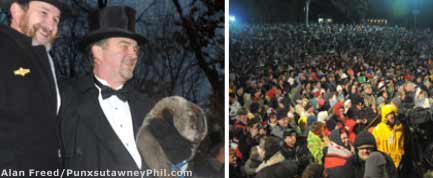Punxsutawney Phil Says Six More Weeks of Winter

Punxsutawney Phil saw his shadow today as he was pulled out of his burrow some 65 miles northeast of Pittsburgh. And so, as legend has it, there will be six more weeks of winter.
Phil also "proclaimed that his beloved Pittsburgh Steelers were World Champions one more time," his handlers said, and to be sure the woodchuck, known popularly as a groundhog, got that one right.
Whether Phil knows how long winter will last is, well, another story.
The legend stems from a German tradition that holds if a hibernating animal casts a shadow on Feb. 2, the Christian holiday of Candlemas, then winter will last six more weeks. No shadow, and spring should arrive early. More specifically, the legend states: "For as the sun shines on Candlemas Day, so far will the snow swirl in May..."
Why hibernate?
Call them groundhogs or woodchucks, these small furry mammals are one of several species of marmots. They can be up to 2 feet long and around 9 inches tall, weighing some 13 lbs.
They can emerge from hibernation during a warm spell at any time of the year, explains Doug Inkley, wildlife biologist with the National Wildlife Federation.
Sign up for the Live Science daily newsletter now
Get the world’s most fascinating discoveries delivered straight to your inbox.
Most groundhogs in the wild will sleep through to spring to finish their winter's hibernation, a seasonal behavior that is key to their long-term survival.
"The fact of the matter is there's nothing inherent in woodchuck behavior that says that they're going to come out on February second, or that what happens on February second is going to be any indication of an early end of winter," Inkley said a couple years back in explaining all this to LiveScience.
"They have [Punxsutawney Phil] living in captivity," Inkley said. "It's in a cage and they take care of the woodchuck in captivity throughout the year and when February second comes they take Punxsutawney Phil out of the cage and hold him up and see if he casts a shadow."
In response to the harsh conditions of winter, some animals hibernate—a state of reduced activity which slows breathing and lowers body temperature and metabolic rate. Hibernation, also called torpor, allows animals to conserve energy when food is scarce.
"There's less food around in the winter months, so there's less energy available and you have to work harder to find it," said Hannah V. Carey, a researcher at the University of Wisconsin. "Plus, for animals that hibernate in the cold regions there's a higher energy demand because when it's colder it takes more energy to maintain your internal body temperature."
How hibernation works
Once the chilly season rolls in, leptin—a protein hormone that regulates appetite and metabolism—signals a pause in food intake during hibernation. But as temperatures start to rise, leptin production goes down and stimulates the appetite of the slumbering animals. Unlike the passive mechanism of going into hibernation, which takes little energy, coming out of hibernation requires groundhogs [image] and other sleepers to increase their metabolic rate.
The higher metabolic rate associated with coming out of hibernation is very energy expensive, especially if it happens prematurely.
First off, a "waking" animal, such as a groundhog, has to start shivering its muscles, which takes a lot of energy, said Terry L. Root, a researcher from Stanford University. Additionally it has to start up processes associated with metabolism.
Animals use stored fat as the fuel for coming out of hibernation, Root explained. That gets used up when the animal wakes up. If there's nothing out there to eat, they return to torpor. The second time they wake up, the fat is all gone and animals must resort to using their muscles as fuel, "and that's very, very harmful," she said.
Phil seems to have done just fine. His handlers claim Phil — and there is only one Phil — has been making forecasts for 120 years and that he's been right every year.










